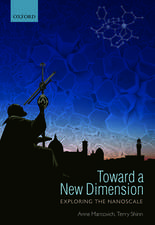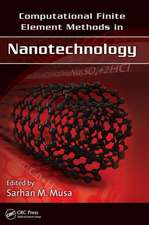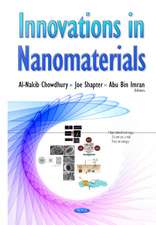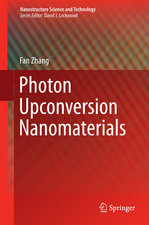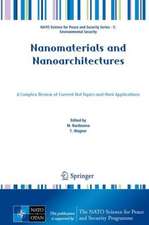Nanobioelectronics - for Electronics, Biology, and Medicine: Nanostructure Science and Technology
Editat de Andreas Offenhäusser, Ross Rinaldien Limba Engleză Hardback – 6 feb 2009
| Toate formatele și edițiile | Preț | Express |
|---|---|---|
| Paperback (1) | 643.16 lei 6-8 săpt. | |
| Springer – 29 noi 2010 | 643.16 lei 6-8 săpt. | |
| Hardback (1) | 649.39 lei 6-8 săpt. | |
| Springer – 6 feb 2009 | 649.39 lei 6-8 săpt. |
Din seria Nanostructure Science and Technology
- 18%
 Preț: 1114.65 lei
Preț: 1114.65 lei - 18%
 Preț: 1001.02 lei
Preț: 1001.02 lei - 24%
 Preț: 834.57 lei
Preț: 834.57 lei -
 Preț: 405.66 lei
Preț: 405.66 lei -
 Preț: 405.28 lei
Preț: 405.28 lei - 18%
 Preț: 947.35 lei
Preț: 947.35 lei - 18%
 Preț: 734.27 lei
Preț: 734.27 lei - 15%
 Preț: 696.02 lei
Preț: 696.02 lei - 20%
 Preț: 585.29 lei
Preț: 585.29 lei - 20%
 Preț: 556.90 lei
Preț: 556.90 lei - 15%
 Preț: 646.62 lei
Preț: 646.62 lei - 18%
 Preț: 952.89 lei
Preț: 952.89 lei -
 Preț: 397.97 lei
Preț: 397.97 lei -
 Preț: 406.05 lei
Preț: 406.05 lei - 18%
 Preț: 967.08 lei
Preț: 967.08 lei - 18%
 Preț: 947.50 lei
Preț: 947.50 lei - 18%
 Preț: 948.29 lei
Preț: 948.29 lei - 18%
 Preț: 950.03 lei
Preț: 950.03 lei - 18%
 Preț: 951.29 lei
Preț: 951.29 lei - 18%
 Preț: 948.92 lei
Preț: 948.92 lei - 18%
 Preț: 960.13 lei
Preț: 960.13 lei - 19%
 Preț: 559.01 lei
Preț: 559.01 lei - 15%
 Preț: 694.69 lei
Preț: 694.69 lei - 15%
 Preț: 635.15 lei
Preț: 635.15 lei - 15%
 Preț: 640.06 lei
Preț: 640.06 lei - 18%
 Preț: 948.79 lei
Preț: 948.79 lei - 20%
 Preț: 564.27 lei
Preț: 564.27 lei - 20%
 Preț: 628.33 lei
Preț: 628.33 lei - 15%
 Preț: 647.59 lei
Preț: 647.59 lei - 15%
 Preț: 643.16 lei
Preț: 643.16 lei - 15%
 Preț: 643.34 lei
Preț: 643.34 lei - 18%
 Preț: 955.08 lei
Preț: 955.08 lei - 15%
 Preț: 587.72 lei
Preț: 587.72 lei - 15%
 Preț: 649.87 lei
Preț: 649.87 lei - 15%
 Preț: 646.43 lei
Preț: 646.43 lei -
 Preț: 388.72 lei
Preț: 388.72 lei - 18%
 Preț: 955.25 lei
Preț: 955.25 lei - 5%
 Preț: 716.75 lei
Preț: 716.75 lei - 18%
 Preț: 952.89 lei
Preț: 952.89 lei - 18%
 Preț: 1258.46 lei
Preț: 1258.46 lei
Preț: 649.39 lei
Preț vechi: 763.99 lei
-15% Nou
Puncte Express: 974
Preț estimativ în valută:
124.27€ • 128.96$ • 103.87£
124.27€ • 128.96$ • 103.87£
Carte tipărită la comandă
Livrare economică 15-29 martie
Preluare comenzi: 021 569.72.76
Specificații
ISBN-13: 9780387094588
ISBN-10: 038709458X
Pagini: 338
Ilustrații: XIV, 338 p.
Dimensiuni: 155 x 235 x 21 mm
Greutate: 0.67 kg
Ediția:2009
Editura: Springer
Colecția Springer
Seria Nanostructure Science and Technology
Locul publicării:New York, NY, United States
ISBN-10: 038709458X
Pagini: 338
Ilustrații: XIV, 338 p.
Dimensiuni: 155 x 235 x 21 mm
Greutate: 0.67 kg
Ediția:2009
Editura: Springer
Colecția Springer
Seria Nanostructure Science and Technology
Locul publicării:New York, NY, United States
Public țintă
ResearchCuprins
DNA-Based Nanobioelectronics.- DNA-Mediated Assembly of Metal Nanoparticles: Fabrication, Structural Features, and Electrical Properties.- DNA-Based Nanoelectronics.- DNA Detection with Metallic Nanoparticles.- Label-Free, Fully Electronic Detection of DNA with a Field-Effect Transistor Array.- Protein-Based Nanobioelectronics.- Nanoelectronic Devices Based on Proteins.- S-Layer Proteins for Assembling Ordered Nanoparticle Arrays.- Electrochemical Biosensing of Redox Proteins and Enzymes.- Ion Channels in Tethered Bilayer Lipid Membranes on Au Electrodes.- Fluorescent Nanocrystals and Proteins.- Cell-Based Nanobioelectronics.- Spontaneous and Synchronous Firing Activity in Solitary Microcultures of Cortical Neurons on Chemically Patterned Multielectrode Arrays.- Nanomaterials for Neural Interfaces: Emerging New Function and Potential Applications.- Interfacing Neurons and Silicon-Based Devices.- Hybrid Nanoparticles for Cellular Applications.
Textul de pe ultima copertă
The different aspects of bioelectronics reviewed in this book emphasize the immense developments in the field of bioelectronics and nano-bioelectronics. The range of themes addressed emphasize key aspects and the future perspectives of nano-bioelectronics. The book discusses the electronic coupling of DNA and proteins with electronic devices to build new information systems and to apply the systems as biosensors. The exploitation of networks of neurons connected with electronic devices in future information processing systems and the use of nano-objects to assess cellular function is also discussed in detail. The various topics addressed in this book will be of interest to physicists, chemists, biologists, material scientists and engineers, as well as attract young researchers and introduce them to the field with an enormous collection of literature references.
Caracteristici
One of the first books on nanobiotechnology, this volume will survey the many results in this rapidly developing field

